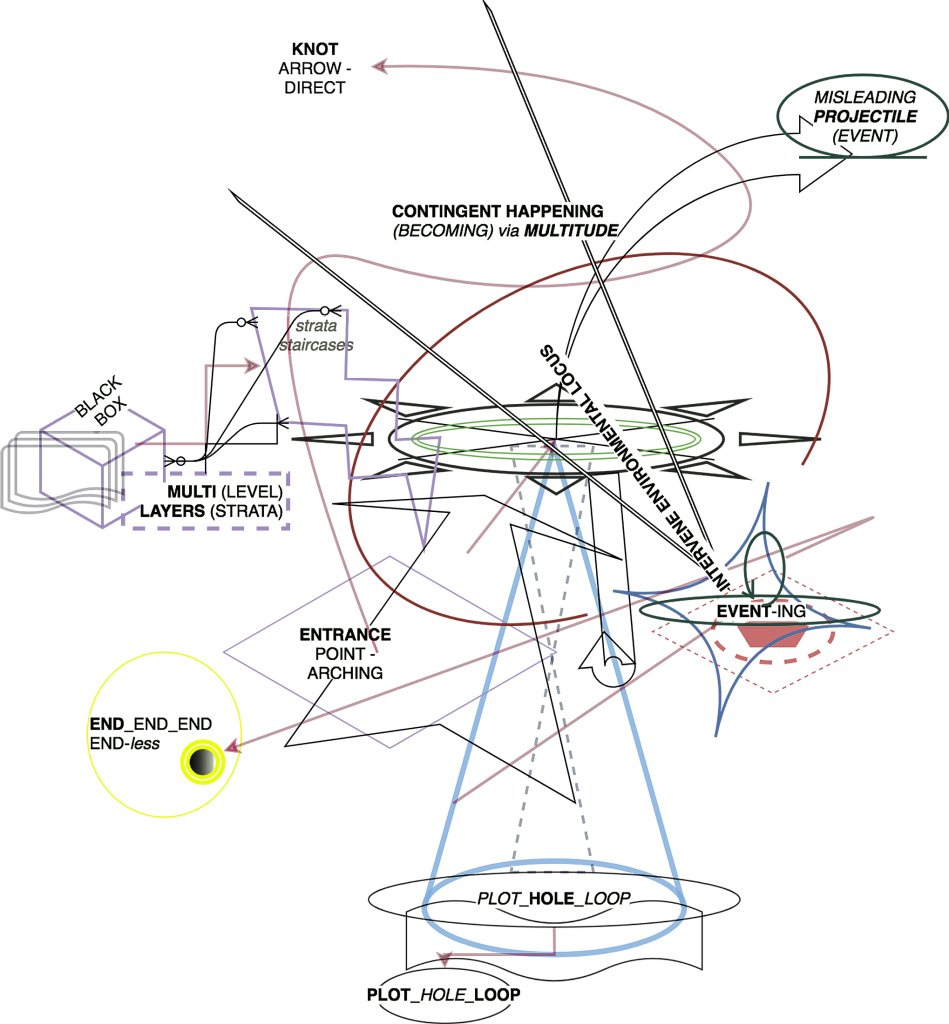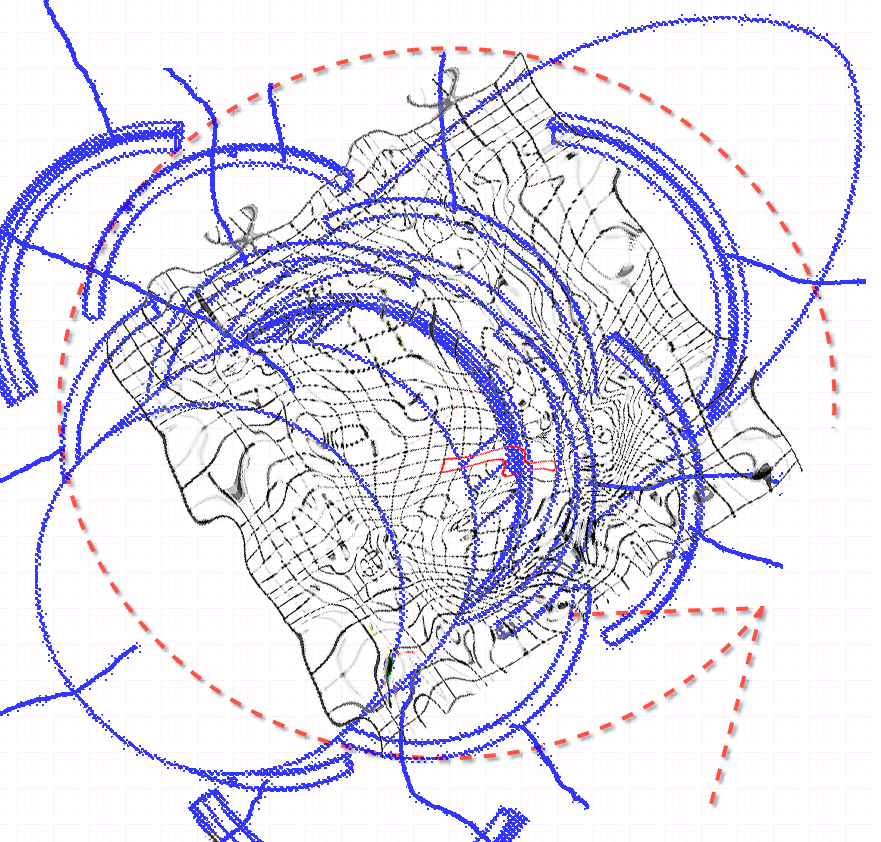1. To outdraw the introduction… (1)
‘The kill-chain can be thought of as a dispersed and distributed apparatus, a congeries of actors, objects, practices, discourses and affects, that entrains the people who are made part of it and constitutes them as particular kinds of subjects(2).’
… one has to think about where the fired shots end up making black holes. And black holes are virtual features, nothing other than hole-complicated portals into everything or anything that is truer than an algorithm unless a metaphor is permitted. Nothing here is more important than anything else -elsewhere. Conceptual powers and human expectations, we may not have known this in vain, will eventually be saturated by nonsense. Make sure you are on the other side of this page-event. The event-as-incident continues to unfold, while still, your presence occurs where there is no knowledge. Could we think in the negative, and so associate war terminology with that of the world, or perhaps worlds of art? How much are the aftermaths of isolation and regional ‘bloc’ divisions of our ever-becoming Eastern European contextual grids, actually factual and prone to be rendered reasonably in our cross-generational coordinates of vantage & vanishing points? Points as predicated in terms of war-vision or the vision of war technology at a long-distance range. And how much is this actually a fictitious and blindfolded abstraction of the relative traditions that these zones share? The exhibition does not allow answers to such questions; however, they resonate within the generic scope of language patterns, through poetical lenses and conceptual categories of inter-national- medial (re) presentations and their assemblies – which shatter some expected notions of these precisely imaginary boundaries, overcoming the initial question.
Misleading projectiles at-large are attempts to point out via a holistic and multi-modal curatorial approach, the procedural conceptualization of the betraying performances within the interspace, battling the local and global gluing, that which suspends the post-pandemic ‘ballistic’ art world. Global and local notions are becoming indeterminable from the viewpoint of individual perspectives, encompassing the momentum of problematic and permanent transformation, which has been attributed to the corpus of art discourse and approached with the utmost cynicism in terms of a sense of certainty, and, at the same time, of the continual betrayal of proclamations of the end -trends. Therefore, this diagrammatic construct invokes inevitable conditioning for grasping the historical as the actual, the effect value with a twist. Within the contained set of works in the exhibition, a probe of the 21st century model of toy aesthetics is deployed as a vector for the spatial – becoming – computational and reflective interface, hence a flex-glossary is activated by various rocketing points towards a sense of the thing or a sense of being completely external to the content: the local as well as this regional project, projectile via an alternative axle: alterum, to alter, altéré.

A cognitive mash-up of the gallery space, white cube to black-box, opens up the artworks to their internal compatibility and the spaces’ conflicting externality, so that conflictual entities such as the object and the subject (objectiles or subjectiles), this affective contact point at any level, serves as a possible entry point for navigating through the diagram, across the threshold of the idea, and the necessity of its overcoming. By default, it’s a figure of a swerving border line, intrinsically disturbed or unevenly distributed throughout. As for this exhibition and its variable accompanying program, we could conclude with the following (later altered) question.
To what extent is the conception of this project – rather a contextualization of its conditions as a future of chance and outcomes – the working of a purely administrative (project) ideology? Through all sorts of lexical arbitrariness of specific language usage-stats: in arts, markets and their cluster-consuming socialites, all being some sort of a manifest discipline as contemporary practice dependent on transition, which is currently taking place.
2 Entering the space of now–end–here
To untangle this dense, cascading introduction, we have to trace our points of entrance into the paradigmatic explanatory structure via diagrammatic thread; meaning, to further un-box the contexts that this exhibition text is probing. Let’s just imagine the Hegelian end of historicity as our momentum, and since we are unable to switch to the self as chronology as opposed to nature, we are stuck in the state of a so-called paradoxical membrane. In the sense of ethics, in-here, ours is being devoured by the gestural Christian wormhole agencies, the dubious cavities of dialectical poly-lemmas of the everyday – known in psychoanalysis as something like frozen larval subjects, or that which is being considered a subject with a disabled sub-stratum, or the ever subjectile nature of being. This eventuates a possible narrow path destined as the contingent character of the entrance point, ontologically not differing from the point of vanishing or the point of exit.
It is becoming evident so far that this text is also a demonstration of a multi-layered stack as a whim of the environment we inhabit, and so reflecting it is what we contain throughout it. And so, having in mind terms from many stages embedded in this project and thus embodying these features, namely to enter or exit the point of a contingent, parallax state, we are switching in scale from being concrete – abstract, mixing up the local axis with the global stance. Being able to witness our knotted entanglements and affairs, we may have a chance to realize and enable them as sensitivities towards our interventions, to drift the course of currents in the environmental locus of the aforementioned nodes. As a closure to the installment, for a given primacy of the exemplary function over (re)presentative; a diagram, is proposed as a spatial rendering, a topographical space of relations applicable to the experiential grids we feedback into our surroundings.
In the midst of accidental mega-structures, new juvenile generations of bodies operate regardless of the state of unknowing themselves. Meaning: if you do not match this body, as nobody, you cannot match the arrangements of history. The denseness of this language is hence the denseness of its apprehension of the reality it withstands. This co-production of new questions is in the manner of Wittgenstein’s and Benjamin’s notions of, on the one hand, the status of the world as perceptiveness, and on the other, concerns over the status of the objects (of art) in the midst of ongoing issues as spectacles – if we may designate them as such – of war, flatness, terraforming, extinction, NFT’s, gateways, abrupt shifts, killer drones, autonomy, AI, GAI and a platitude of emerging accompanying phraseology in hyper flux.
No theory is chick enough to satisfy our pre-emptive horizontal incapacity for reason. Since we still fail through misconceptions of concepts in polarities as the analog versus digital, (3) virtual versus real etc. we may notice already that this misleading or failing figure is prone to the structure of the text in its attempt to establish or localize the terms for the constitution of subjectile and objectile -projectiles intertwining so forth. It is to ask, what is that which fuels our core drive, that which is navigating the landscape where when is rather than what.
3 Function hyphen– or else- an exit- the outsideness
‘But how much more pleasant was the sensation of being a missile without provenance of target, caught up in a tumult of non-Newtonian motion. So pleasant that pleasant was not the word.’ (4)
Many will succeed and recoup from the aftermath while many will only mourn the old world of cruelty due to the collapse, right after the upgrading taking place now, and precisely via the pre-established rules of the other level of becoming i.e., coming into being of this new world. So how do we approach this need for exit, or at least the ‘outside-ness’ it entails? The closest example is a black hole which sinks through and out, as a pupil, an eye, a focal instrument or tool of desire that curates the manifesting image features across life’s pace, a grid-like system where all disturbances are vortexes that wrap a certain collided area of the grid. This posturing is surely a neologism, namely a graph-ontology. As a speculative topographical space, it entails performative functions and paradigms, that is to say, certain regimes and technologies:
to work on a concept is to vary its extension and comprehension, to generalize it through the incorporation of exceptional traits, to export it beyond its region of origin, to take it as a model or inversely, to search for a model for it – in short, to progressively confer upon it, through regulated transformations, the function of a form. (5)
4 Grids & Wrappings
‘In the end there will be no end. / Just open-ended suggestion’? (6)
… or just the right to subsist. Alternative to what?
It’s not just that this kind of exhibition-making is always too late and consequently artificial, it is also becoming obsolete, configured by a backdrop of social struggles and relations between classes that are being imprinted in the structure of artworks (historically). In a Landian frame, whose alignment of appearance as sensory & symbolic impact is resulting from a complex dynamic of projections (in stacks), hence suggesting it is inevitably transparent, limiting logic, the sense of the self wrapped by the substitute of gridding.
The dead-end of avant-garde delivers an abrupt number of citizens for which no-thing will be contained in/by time. If one is without the capacity of being a tool at hand, the tool of the being henceforth is subject to the humiliation of time wasted in a world of non-generative functions. The machine-vision of a tool-being as sampled historically through the shaping of a bone missile or a stone projectile, the naive physics of prehistoric defense has been uncovered and advanced, via forensics, into the latest nuclear heuristics.
The dices are thrown and a cisgender apolitical ant-empire hay-o-feminism is without time, only its ambition flourishes at the states’ capacity of the un-cooling curatorial eye and a silver tongue of unprecedented cunning of the contingent and generative gambling via sequences of assembled vectors with hinged vortexes. Have we now reached the nonsensical vanishing point of text, or as Brassier would address by just naming that which is being addressed as: the genre is obsolete?
This persuasion that is winning over the language-game-play of toy aesthetics implies a sort of a cognitive model of art & its works which are engaging in philosophical vantage points, probing the onto-episteme-logical concomitants to some art phenomena entangled in a joint. The artworks are eventual events (even-ting) as also the constituencies of the world coming to an end, the real and immanent constructs, as counterfactuals shared by the subjectiles and objectiles. The choices cast by the dice are the misleading projectiles of why, and where are those choices actually culminating in a universal force?
The dice has been thrown by a looking glass entity, randomized already by suddenness […] Physical phenomena generally take the most optimal route of motion. To a blown projectile, its orientation is self-parallel, or so to say self-referential. To kill its complicity and intensity while domesticating it into the pattern of motion and action, both effectuating the projectile as a dispersive particle in speculative space which avoids reason.
The end of the artist was an inevitable proclamation, as a suicide through a massive multiplicity. As Salemy sets forth: the final kick that pushed the artistry into its historical grave was growth of information about art. (7) It is useful to mention or rewind, that a compiled set of artworks in a show deploy a variable of the following three models of aesthetics, as proposed by Reza: the ineffable, the instrumental and the toy. (8) Drone geographies are introduced by bringing closer the foreign and far regions which are paradoxically dealing with remote violence (as in the arts, and across mobile screens), the difference almost being an issue of physics, the implosion of the arts as the explosion of the wars. As a feature it could be or pretend any kind of object or physicality, as a predatory re-appearing or as a reverse reason, a counter-discourse or a nagging one, the abjective (abjectile). An attempt to steer art towards a certain end, namely, its exit from the contemporary ready-made political program with the question: ‘what is to be done?’ When only good ideas can become concrete.
When someone announces their future promises and marital status, does it increase (that-is) a gesture of commitment that leads to a paralyzed judgment of conceptual trajectories? That leads to a monadic logic in relation to the ‘real’. The condition of arts futures on a plane of political geographies after the internet. Euro-passé is the angle of view of so-called Eastern Europe in neuro-pace. Why would an author or curator, just by living in the zones of E.E., be obliged to deal with the issues of the E.E? (9) Igor Zabel asks this of mitteleuropa. A precarious journey of nagging back the discourse, deploying a copycat as a figure of speech in the text. Bad trip of the performative, trolling idiotic figure without shame:
Yeah! Capitalism is optimism as optimization is a farce, of absurdity in our regional political thriller landscapes as we inhabit in reality.
Boris Buden is just overburdening our vocabulary, applying such terms as: peripheries, central, eastern, western, middle, -ness-ness, semi, the-new-, anew- (10), etc. Aside from the currency of the slow-motion hype in Acc’s increasing set of variable awareness modalities and mindless fathoming on ideological scrambles, the crisis is seen as parasitic militarization and is just falsely presumed as a stopping point with the threat of becoming permanent. This primacy of enemy production laws is not just to immobilize, but moreover to identify and localize. A reversal of the scenario as in: art which subjugates politics?
Noise is figured into the spectrum of object-subject-abject-al formatting, the meta-generic convention as having sex with drones over the scenery of speculating on tech as a form of metabolic vehicle, gun, rocket engineer that performs rituals with the intention of conjuring a vessel, to carry and direct the overseer by the force against the abyss.

_____
Notes
1. ALTERUM project – Artist-run network in the CEE region. This exhibition is organized at U10 Art Space from 07-13/06/2021. in Belgrade (Serbia). Exhibiting artists: Pavle Banovi? (RS), Mate Elod Janky (HU), Inka Kar?akova (SK), Aleks Selmeci and Tomaš Kocka Jusko (SK), Šimon Sýkora (CZ), Maks Vajt (CZ), Ádám Varga (HU), Vanja Žuni? (RS). Curated by Darko Vukic.
2. From a View to a Kill; Drones and Late Modern War, by Derek Gregory.
3. In Art, the digital – analog division became a Culture War, with bizarre patriotism on both sides, each developing parallel theoretical discourses, conference circuits, journals, relations with or hostilities toward other disciplines within the academy, etc. […] There was real cultural capital at stake for the cultivation and weaponization of both Analog Pastoralism and Digital Millenarianism and or Secessionism: dismagazine.com/discussion/73272/benjamin-bratton-machine-vision.
4. This quote is extracted from ‘The Sex of Drones’, written by Benjamin Noys in 2017. Its origin is from the ‘Murphy’, by Samuel Beckett.
5. Concept and Form, Volume 1: Selections from the (journal) Cahiers Pour L’Analyse. Published by Verso, 2012.
6. Kode9 & the Spaceape, Memories of the Future (2006).
7. The End of Artists, Mohammad Salemy, Arts of the Working Class #8.
8. On Toy Aesthetics: Wittgenstein’s Pinball Machine (part 1); Reza Negarestani (toyphilosophy.com).
9. Angle of View, Igor Zabel. Published in- præsens journal, issue-1, 2005.
10. The End of the End (of Post Communism). In Conversation with Boris Buden; Blok magazine, 2015.
